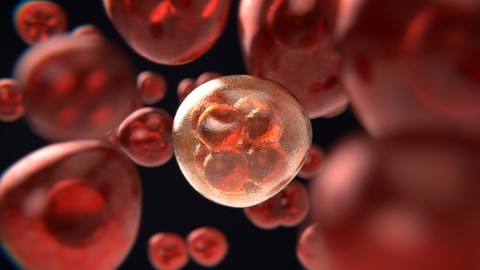
Human Reproduction in Biology: An Introductory Course
Human Reproduction in Biology: An Introductory Course, available at $19.99, has an average rating of 3.9, with 30 lectures, based on 23 reviews, and has 1110 subscribers.
You will learn about Puberty & Sex hormones Importance of Reproduction Secondary Sexual characteristics in males & females Male & female reproductive systems and their functions Menstrual Cycle Fertilisation Child Birth Birth Control Methods Sexually transmitted Infections Parental Care This course is ideal for individuals who are Anyone who seeks knowledge about the topic or College students or School students or University students or freshman or anyone from any field It is particularly useful for Anyone who seeks knowledge about the topic or College students or School students or University students or freshman or anyone from any field.
Enroll now: Human Reproduction in Biology: An Introductory Course
Summary
Title: Human Reproduction in Biology: An Introductory Course
Price: $19.99
Average Rating: 3.9
Number of Lectures: 30
Number of Published Lectures: 30
Number of Curriculum Items: 30
Number of Published Curriculum Objects: 30
Original Price: $89.99
Quality Status: approved
Status: Live
What You Will Learn
- Puberty & Sex hormones
- Importance of Reproduction
- Secondary Sexual characteristics in males & females
- Male & female reproductive systems and their functions
- Menstrual Cycle
- Fertilisation
- Child Birth
- Birth Control Methods
- Sexually transmitted Infections
- Parental Care
Who Should Attend
- Anyone who seeks knowledge about the topic
- College students
- School students
- University students
- freshman
- anyone from any field
Target Audiences
- Anyone who seeks knowledge about the topic
- College students
- School students
- University students
- freshman
- anyone from any field
This course has been designed for anyone who is interested to learn about the male and female reproductive systems of human. This is good for general knowledge as well as it has the exam specification of Anatomy/ Physiology/ Biology/ IGCSE/ GCSE/ O level/ AQA/ CheckPoint and Other syllabus. After the completion of this course you will be able to:
-
Identify and name on diagrams of the male reproductive system: the testes, scrotum, sperm ducts, prostate gland, urethra and penis, and state the functions of these parts
-
Identify and name on diagrams of the female reproductive system: the ovaries, oviducts, uterus, cervix and vagina, and state the functions of these parts
-
Describe fertilisation as the fusion of the nuclei from a male gamete (sperm) and a female gamete (egg cell/ovum)
-
State the adaptive features of sperm, limited to flagellum and the presence of enzymes
-
State the adaptive features of egg cells, limited to energy stores and a jelly coating that changes after fertilisation
-
State that in early development, the zygote forms an embryo which is a ball of cells that implants into the wall of the uterus
-
State the functions of the umbilical cord, placenta, amniotic sac and amniotic fluid
-
Outline the growth and development of the fetus in terms of increasing complexity in the early stages and increasing size towards the end of pregnancy
-
Describe the ante-natal care of pregnant women, limited to special dietary needs and the harm from smoking and alcohol consumption
-
Outline the processes involved in labour and birth, limited to:
– breaking of the amniotic sac
– contraction of the muscles in the uterus
wall
– dilation of the cervix
– passage through the vagina
– tying and cutting the umbilical cord
– delivery of the afterbirth�
-
Compare male and female gametes in terms of size, structure, motility and numbers
-
Explain the adaptive features of sperm, limited to flagellum, mitochondria and enzymes in the acrosome
-
Explain the adaptive features of egg cells, limited to energy stores and the jelly coat that changes at fertilisation
-
Describe the function of the placenta and umbilical cord in relation to exchange of dissolved nutrients, gases and excretory products and providing a barrier to toxins and pathogens (structural details are not required)
-
State that some toxins, e.g. nicotine, and pathogens, e.g. rubella virus, can pass across the placenta and affect the fetus
-
Discuss the advantages and disadvantages of breast-feeding compared with bottle-feeding using formula milk
-
Describe the roles of testosterone and oestrogen in the development and regulation
of secondary sexual characteristics during
puberty� -
Describe the menstrual cycle in terms of
changes in the ovaries and in the lining of the
uterus -
Describe the sites of production of oestrogen
and progesterone in the menstrual cycle and
in pregnancy� -
Explain the role of hormones in controlling
the menstrual cycle and pregnancy, limited to
FSH, LH, progesterone and oestrogen� -
Methods of birth control in humans�
-
Outline the following methods of birth
control:
– natural, limited to abstinence, monitoring
body temperature and cervical mucus
– chemical, limited to IUD, IUS,
contraceptive pill, implant and injection
– barrier, limited to condom, femidom,
diaphragm
– surgical, limited to vasectomy and female
sterilisation
Supplement� -
Outline the use of hormones in contraception
and fertility treatments� -
Outline artificial insemination (AI)�
-
Outline in vitro fertilisation (IVF)�
-
Discuss the social implications of
contraception and fertility treatments� -
Sexually transmitted infections (STIs)�
-
Define sexually transmitted infection as an
infection that is transmitted via body fluids
through sexual contact� -
State that human immunodeficiency virus
(HIV) is an example of an STI� -
Explain how the spread of STIs is controlled�
-
Describe the methods of transmission of HIV�
-
State that HIV infection may lead to AIDS�
-
Outline how HIV affects the immune system,
limited to decreased lymphocyte numbers
and reduced ability to produce antibodies
Course Curriculum
Chapter 1: Introduction
Lecture 1: Introduction
Lecture 2: Importance of Reproduction/ Puberty & Sex Hormones
Lecture 3: Sexual Reproduction in Humans
Chapter 2: Male Reproductive System in Humans
Lecture 1: Human Male Reproductive System
Lecture 2: Function of Male Reproductive Organs
Lecture 3: Function of Semen – Seminal Fluid
Lecture 4: Summary of Male Reproductive System
Lecture 5: Function of Male Reproductive Organs – Part 1
Chapter 3: Female Reproductive Systems in Humans
Lecture 1: Female Reproductive System
Lecture 2: Functions of female reproductive organs Part – 2
Lecture 3: Summary of female reproductive system
Chapter 4: Sexual Intercourse
Lecture 1: Male & Female Gametes
Lecture 2: Sexual Intercourse
Lecture 3: Transfer of Semen
Chapter 5: The Menstrual Cycle
Lecture 1: Timeline
Lecture 2: Menstrual Cycle
Lecture 3: Role of Hormones in Menstrual Cycle – Graphical Representation
Lecture 4: Cycle of Follicle Development
Lecture 5: Summary of menstrual cycle & fertilisation
Chapter 6: Fertilisation & Development of Human Foetus
Lecture 1: Fertilisation
Lecture 2: Events happened after Fertilisation
Lecture 3: After Implantation – Gestation Period
Lecture 4: Development of Human Foetus
Lecture 5: Role of Placenta & its Adaptations
Chapter 7: Child Birth
Lecture 1: The Birth Process
Lecture 2: Parental Care
Lecture 3: Comparison of Breast Milk & Formula Milk
Lecture 4: Birth Control Methods
Chapter 8: Sexually Transmitted Infections (diseases)
Lecture 1: Sexually Transmitted Infections (diseases)
Chapter 9: Bonus Lecture
Lecture 1: Growth & Development (IGCSE/ GCSE Definitions/ Keywords)
Instructors
-
Humaira Asim
Science/ Biology/ Chemistry Expert
Rating Distribution
- 1 stars: 2 votes
- 2 stars: 2 votes
- 3 stars: 2 votes
- 4 stars: 6 votes
- 5 stars: 11 votes
Frequently Asked Questions
How long do I have access to the course materials?
You can view and review the lecture materials indefinitely, like an on-demand channel.
Can I take my courses with me wherever I go?
Definitely! If you have an internet connection, courses on Udemy are available on any device at any time. If you don’t have an internet connection, some instructors also let their students download course lectures. That’s up to the instructor though, so make sure you get on their good side!
You may also like
- Best Investing Courses to Learn in March 2025
- Best Personal Finance Courses to Learn in March 2025
- Best Health And Wellness Courses to Learn in March 2025
- Best Chatgpt And Ai Tools Courses to Learn in March 2025
- Best Virtual Reality Courses to Learn in March 2025
- Best Augmented Reality Courses to Learn in March 2025
- Best Blockchain Development Courses to Learn in March 2025
- Best Unity Game Development Courses to Learn in March 2025
- Best Artificial Intelligence Courses to Learn in March 2025
- Best Flutter Development Courses to Learn in March 2025
- Best Docker Kubernetes Courses to Learn in March 2025
- Best Business Analytics Courses to Learn in March 2025
- Best Excel Vba Courses to Learn in March 2025
- Best Devops Courses to Learn in March 2025
- Best Angular Courses to Learn in March 2025
- Best Node Js Development Courses to Learn in March 2025
- Best React Js Courses to Learn in March 2025
- Best Cyber Security Courses to Learn in March 2025
- Best Machine Learning Courses to Learn in March 2025
- Best Ethical Hacking Courses to Learn in March 2025






















